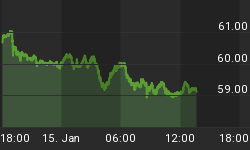It should correct over the short-medium term. In the U.S., the unemployment rate is instead set to decline few more points, before resuming the long-term uptrend. Spanish banks saved or not?
Unemployment is rising again?
After three good months above 200,000, employment declined again from March to May. Is recent weakness temporary or just the beginning of a negative spiral? According to the study of cycles, the unemployment rate could tick down few more points to 8.0%-7.8%, before resuming the long-term uptrend. Let us see why. Since 1948, the unemployment rate had two bullish cycles (1952/61, 1969/1982). Movements lasted for 9/13 years and extended 63%-67% top/bottom. They all climbed in three distinct waves, before collapsing. Within these secular bull-cycles, the unemployment rate topped/bottomed every 4/6 years. Corrections have instead continued for 1/3 years top/bottom. How would it fit in today's scenario? Unemployment began in 2000. It topped in 2003, bottomed in 2007 and completed the second wave in 2009. It extended for 60% top/bottom. A third and final wave is still lacking. It could be expected between 2012/2013, if history repeats itself. In effect, the Fed appears to be hesitant over the measures to take during the next meeting of June 19/20. Mr. Bernanke said rapid gains in the economy are necessary to achieve more improvement in the job market. Consequently, bold actions might be necessary. However, they require a close consensus, which is difficult to build in such a short period of time.
The best choice would be to wait for more signs of weakness before promoting Q3 or a further maturity extension program. In fact, the former would also stimulate inflation, while the latter could not be that beneficial for the economy with yields so low. The U.S economy has lost momentum, but still has the capacity to overcome the challenge. The G.D.P. only suffered a limited slowdown, after the positive results shown in the first part of the year. On other hand, the employment sector of the I.S.M. survey gave back almost 6 points from January to May. Nonetheless, actual numbers are coherent with a monthly job creation of about 150,000. Finally, corporate earnings are still trending. The major obstacle is set by the so called "fiscal cliff" at the beginning of 2013, when many tax reductions will expire and the budget cut passed in 2011 will take effect. The next Administration should correct the issue in the shortest period of time. In this volatile environment, the U.S. dollar maintains its safe-haven status, but the market appears to be oversold. The U.S. dollar index is leaning against two long-term lines. In addition, futures funds are again enormously long the dollar.

German's growth is fading?
After months of superior performance, troubles of the euro zone are beginning to weigh on the German economy. In April, manufacturing production showed the deepest contraction (-2.4% month to month) since 2009. All sectors were weak, particularly consumer and capital goods. Industrial production fell instead 2.2% month to month, as construction slumped 6% in April. Industrial production has been declining since July 2011. The contraction in manufacturing orders might anticipate weaker numbers in the months ahead. Exports are not trending anymore. They declined 1.7% m/m in April.
What could happen now? The European Central Bank (E.C.B.) said its decisions on important policy rates are based on inflationary trends. Well, inflation should remain subdued for few more months and could move below E.C.B. target of 2.0%. So, a cut of 25/50 basis points is in the cards. Nevertheless, these moves are only the tip of the iceberg. The E.U. and the European governments are expected to implement radical reforms. The size of the EMS and EFSF must be increased. A closer fiscal on political union is mandatory. As an example, the Redemption Fund could help sterilize debts for a few decades. Finally, lending to the private sectors is mild and decreasing. As a result, growth should be supported.
Europe versus Japan: a different treatment?
The I.M.F. calculates Spain would need euro 40 billion to recapitalize its banks. The Spanish Prime Minster, Mr. Rajoy, asked for help and Spain will get up to euro 100 billion from the E.U. Under normal circumstances, Spain would have the resources to face the challenge, considering the size of its economy and the state of the finances. In fact, if payments occur in 2012, the ratio of government debt to the G.D.P. would rise by only few points to around 80% (less than Germany). Nevertheless, current situation is anything but normal. Rating agencies waited for the Japanese government debt to pass 130% before acting. At the contrary, Spain lost its triple A in 2009, when its debt was only 40% of G.D.P.
Despite the efforts of the government to reduce its debt, the rating has been cut five times since then. It is now considered a triple B, which makes it quite impossible for Spain to go to the market to find capital. The latest demand at the weekly Main Refinancing Operation (MRO) was about euro 120 billion, way above the average of the previous two months (about euro 45 billion). The only practicable solutions are the European funds (EFSF and ESM). The euro currency should stay under pressure. However, the massive number of short positions held by futures funds anticipates a bottom in the weeks ahead.
















